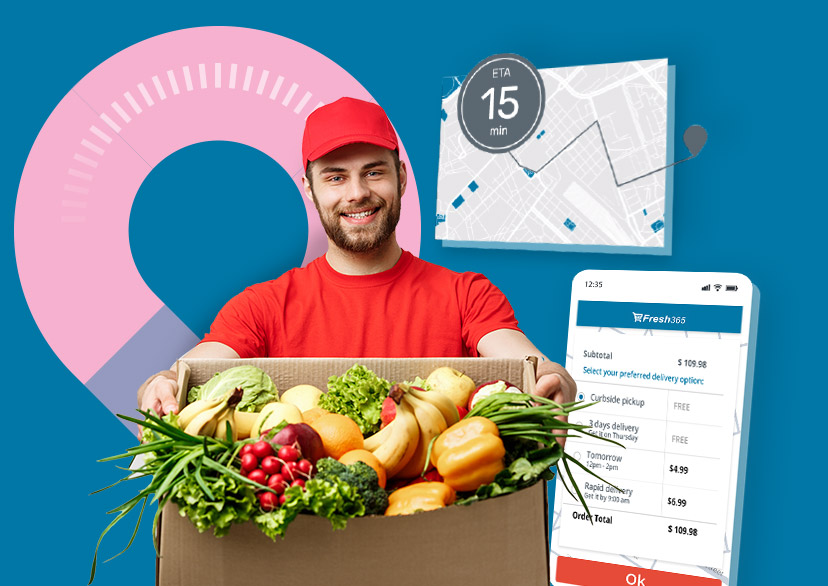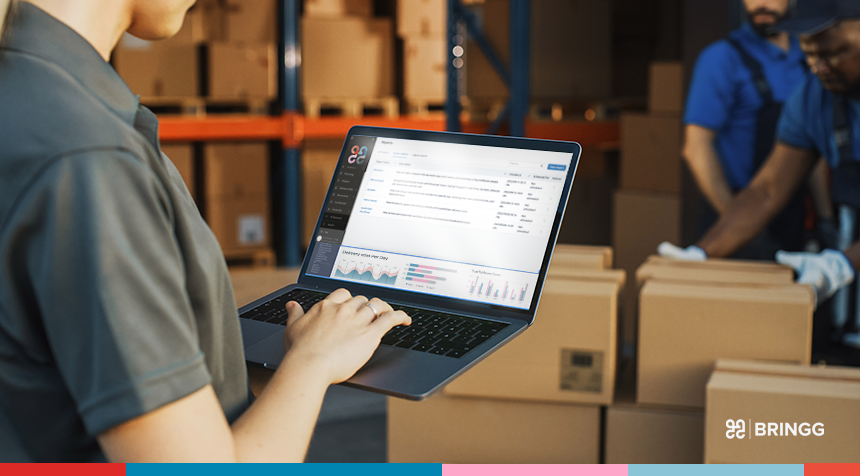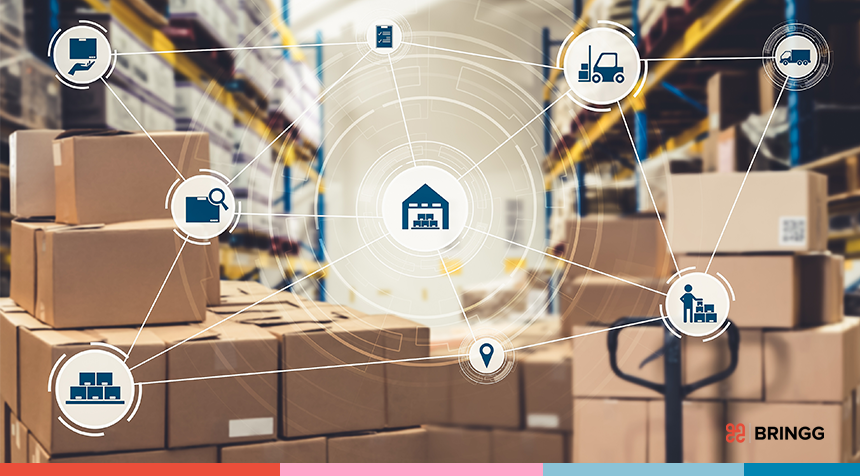Grocery has undergone its biggest change since the industrial revolution. Back in 2019, Online grocery comprised only 2-4% of total grocery sales in the U.S. Today, marketshare is increasingly based on a grocer’s online presence and the maturity of their last mile grocery fulfillment services. Grocery delivery is a must-have for grocers who want to keep up with the market.
This guide explores the trends that are shaping grocery delivery services, and projections for what we will see in the coming years.
How have grocery delivery services changed?
Grocery delivery covers the entire process of fulfilling orders purchased online or in store, and having these items delivered to them.
It’s a complicated process that takes into account a wide variety of factors from the checkout process (delivery vs. pickup, delivery windows, taking drivers and trucks into account to ensure accurate times, inventory in specific locations, etc.), to the order processing phase (who picks the orders off the shelves, where the packing and staging happens and when), to the actual delivery or pickup (having the proper fleet on hand, drivers, communication with customers regarding delays or changes, etc.).
Back in 2019, market penetration for grocery delivery was as low as 4.5% in the U.S., and still in single-digits in most countries. Many U.S. grocery companies provided these services solely through Instacart.
Until recently, most grocery chains did not have many options for grocery delivery, unless they wanted to invest significant time or resources into building or contracting other solutions. The investment in new technology to create a reliable delivery solution was simply too great for all but the largest grocery chains, especially as demand was relatively low. And since online sales were a relatively small percentage of overall sales, chains didn’t focus on developing a better solution that put their fulfillment services under their control.
COVID’s impact on grocery delivery services
COVID’s impact on grocery and online grocery delivery was immediate:
- eGrocery in the U.S. reached $9.3 billion in sales in January, according to one survey (Brick Meet Click / Mercatus).
- Approximately 35% of U.S. households now rely on eCommerce to purchase groceries. It is estimated that the pandemic accelerated the food sector’s reliance on eCommerce by 3-5 years in just a few months.
- Grocery delivery’s compound annual growth rate (CAGR) is now projected to grow by 29% from 2020 to 2024.
With online sales becoming an increasingly important revenue channel, chains that had limited grocery delivery services, or which relied on a single delivery provider, suddenly realized they needed to expand in quality and quantity: reach more customers, with more delivery services, with a greater number of fleets. As grocery delivery became a commodity overnight, focus grew on the quality of delivery: speed, convenience, product availability, safety, and costs.
With delivery volumes higher than ever, the challenges grow exponentially. Having to pick, stage and ship fresh produce and non perishables, refrigerated and frozen foods in all different shapes and volumes, while managing the exceptions that inevitably occur and maintaining, and doing all of this while meeting SLAs, is untenable using strategies and service standards from even a few years ago.

What do the best grocery delivery services offer?
Same-day vs. scheduled grocery delivery – Whereas the average grocery delivery service used to be next-day or later, a growing number of chains are looking to provide a same day delivery service, to better compete with the leading grocers. Convenience grocery in particular is cashing in on consumers’ interest in fast delivery for fresh goods. But without an automated delivery process, managing same-day and on-demand delivery can make it difficult to keep delivery costs down.
Visibility and Transparency – On top of the entire process is the issue of transparency: customers want to know where their order is, when it’s arriving, and even to see it making its way in the truck. This is especially important in the case of groceries because people are stressed to make sure that the order arrives on time so food doesn’t go bad or so they can make dinner as they planned.
A few main grocery platforms have taken control of a critical mass of the market, with Amazon, Walmart and Instacart leading the pack. Their success is due to their exceptional service and selection, together with the ability to provide attractive prices and competitive grocery delivery services. The challenge for grocers today will be to narrow the lead these companies have by expanding their use of independent external fleets, maintaining a direct relationship with shoppers, and enabling better speed, prices, and product availability.
Increasing accuracy, lowering dwell time and upping volume throughput are the key focuses for the majority of grocery retailers.
Nick Schurman, Senior Sales Director, Bringg
Trends in grocery delivery
As brands move away from dependency on a single provider or marketplace, they will explore more fulfillment options, providers and services.
Amazon Fresh and Walmart
Amazon and Walmart have gotten customers used to exceptional convenience and speed. Their massive infrastructure and delivery networks give them a clear advantage as a grocery delivery service by having an internal fleet already set up and ready to ship to customers wherever they are located.
Instacart and Online Marketplaces
At one point in 2020, Instacart held over half of the U.S. grocery market. The platform provides a quick option for retailers looking to add online grocery delivery solutions to their roster of services.
Instacart has gained a large following due to its ease-of-use and wide range of products available on the service. The delivery fees vary depending on several factors and by signing up for a membership, customers get free delivery with a low minimum order amount.
While grocers once approached Instacart as the go-to solution for online order fulfillment, the loss of a direct relationship with customers has made grocery companies look to alternatives, including using Instacart as part of a controlled, multi-fleet management solution for local same-day and next-day delivery. As time goes on, more marketplaces will take control of online fulfillment, creating constraints and dependencies for grocery retailers.

Specialized grocery delivery services are booming
A wide variety of boutique options exist in the grocery delivery scene. Health foods, fresh produce, meat and fish options, cheese stores and alcohol are just some examples of specialty foods that can be found online and delivered straight to your door. These delivery services often have a relatively high minimum order (or at least a high minimum order for free delivery) and tend to work in specific areas and/or regions. Some of these foods require specific vehicle requirements, which is one reason why fleets and service providers often specialize in specific delivery products (e.g. cold storage, heat, etc.)
People looking for a new and easy cooking experience may choose to order meal kits from specialized grocers.This includes receiving all of the ingredients and instructions for meals and then cooking at home. Many grocery stores are also starting to offer prepared fodos, such as salads and sandwiches, blurring the line between a restaurant and grocery delivery service. Both ready-made meals and meal kits are growing in popularity as people spend more and more time at home.
White glove and contactless services
Safety concerns and convenience are two big factors when shoppers choose where to buy groceries online. However, concerns about safety mean that customers and drivers now have to keep their distance. If a few years ago, grocers worked hard to offer over-the-threshold deliveries, they are now marketing contactless delivery methods. These will gain in popularity as more brands digitize their last mile delivery flow, including custom-facing elements like proof of delivery, age verification (for alcohol), payment and tips.
Curbside Pickup
Grocers have been increasingly turning to curbside pickup to fulfill online orders as it is a cost-effective way to increase volume throughput – and because customers love the convenience it offers. A recent Bringg survey found that 55% of retailers currently offer curbside pickup, and another 27% plan to add it within the next year. 77% of retailers plan to section off in-store space dedicated to curbside pick-up and click-and-collect services.
A move to third party fleets and DaaS (delivery as a service)
Very few grocers use internal fleets today due to the massive expense and investment necessary to get launch and maintain such systems. In the event that a grocer does decide to use an internal fleet (on its own or as part as a multi-fleet option), technology is the key to remaining efficient.
The majority of grocers, including big names like Albertsons in the U.S. and Coop in Europe are turning to multiple third party delivery and DaaS fleets to expand their delivery reach and provide the same delivery model across more locations.
Launching new fulfillment models
Every grocery store and chain wants to provide the best grocery delivery services possible. To stay in the game, grocery chains are taking their eCommerce fulfillment into their own hands.
Launching a new fulfillment model is bound up with a wide range of considerations, each of which has implications on the technology needed to create a successful grocery delivery service (more on this later in this guide).
What do the best grocery delivery services offer?
- Offer both on demand and scheduled grocery delivery services
- Work with multiple third party fleets to increase capacity and geographic reach while keeping costs down
- Use delivery and fulfillment platforms for demand-driven services that let them flexibly flexibly multiple owned or third party fleets, maintaining visibility and keeping costs low
- Integrate all order fulfillment systems, so options at checkout (prices and available services) are accurate
- Provide visibility into delivery orders at every stage, including automated notifications
- Provide contactless delivery, including handling item replacement and proof of delivery at the doorstep
- Provide businesses with control over the customer relationship and data
Grocery delivery solutions: are they worth it?
Many grocery brands invest in a grocery delivery solution as their online business expands. The best grocery delivery services provide accurate delivery times at checkout, deliver on time, and engender trust in shoppers. Running such a delivery service across hundreds or thousands of grocery stores requires a grocery delivery platform that can manage thousands of orders, across disparate locations and fleets.
The best grocery services provide transparent and accurate delivery times and information as well as the ability to communicate with shoppers in the event that a certain item is out of stock. Some customers may not want replacement products, others may want to replace an item with another specific product, and others may not care at all. This is a critical feature that the best grocery delivery platforms take into account.
Delivery windows are also a critical factor in choosing a delivery service. Not only must delivery windows be narrow (no one wants to sit around all day waiting for their groceries to arrive), the orders must arrive on time. This is important due to the sensitive nature of cold goods (just imagine melted ice cream landing at a doorstep) as well as people relying on their orders to be able to eat! No grocer wants angry customers whose event was messed up or whose kid couldn’t take a sandwich to school the next day because of a delayed order or missing products.
4 Ways to Make Your Grocery Delivery Service Profitable:
- Create competitive differentiation through multiple fulfillment models at scale
- Offer shorter window availability and personalized slots
- Provide visibility into their order status and location
- Use multiple third party fleets to optimize delivery based on cost to deliver
Forecasts for Grocery
In the next year, grocery delivery will become more complex, more automated, and more local.
- Technology will be key to increasing grocery delivery sales and adoption ratesDepending on services offered, grocers will need access to the right technology and apps in order to guarantee that their service is efficient and profitable so that customers will continue shopping online in the future.The main challenge for grocery retailers is to invest more resources in building an efficient delivery offering while protecting their relatively low 2-3% profit margins.
Source: Bringg, Driving Revenue in Grocery Curbside Pickup and Delivery - Same day service and hyperlocal warehousing will growIt is estimated that by 2030, there will be one micro-fulfillment center for every 10 of the United States’ total 40,000 grocery stores. In other words, 10% of all Grocery stores will run deliver from store services.Why is this happening? Because shippers who choose to offer an on-demand service (aka same day or even one-two hour) rely on hyperlocal fulfillment locations such as MFCs and ship from store options. Technology comes into play here in automatically identifying local inventory availability and presenting relevant options to consumers at checkout. Applications for warehouse and grocery store teams help employees pick, prepare and stage the orders. This includes handling cold and frozen orders properly and making sure that items are packed at the appropriate time, and sent out on vehicles with the necessary storage capabilities.The proper apps and tech here give grocers the ability to offer seemingly instant service, answering a true pain point for online shoppers who need items quickly (think milk, eggs, bread) and don’t want to leave their homes (for a wide variety of reasons including safety).However, there will still be demand for multi-day, scheduled shipping, particularly for larger orders that include non-perishables and home essentials purchased in bulk.
- More brands will manage multiple third party deliveryIn the recent Bringg Barometer survey, 36% of retailers said their biggest challenge to scale is managing multiple third-party fleets. This includes coordinating services and availability between third-party fleets. This management will become more and more necessary as grocers want to expand their reach and offer new services while keeping costs in check. Those who choose to use third-party fleets also must take technological tools into consideration in order to integrate the fleets with their other systems, and create flexibility around dispatching. For example, the most technologically advanced grocery brands can base which order goes to which fleet on customized business considerations like cost, distance, etc. This flexibility can also be a matter of time: contracting additional fleets to handle spillover orders during peak times of day or peak season.If grocers want to be able to flexibly manage multiple fleets and not be locked into one, they will need the necessary software solutions.
- Grocers will reduce prices and cost to deliver through automationThe more costly order fulfillment is to grocers, the higher the delivery fee. Automation in order fulfillment – from picking and staging the groceries in the warehouser or fulfillment location, and all the way to the driver – can significantly reduce costs around order fulfillment and, subsequently, delivery fees.
The experience will be fully digitizedPeople choose where to purchase their grocery and other products based on a variety of factors:- product availabilitytrust in the brandproduct pricesdelivery feeThe speed and convenience of the fulfillment options offered
Frequently asked questions
What are the top trends in the grocery industry?
- Convenience and speed are being prioritized by grocers
- Instacart and other online marketplaces are proving to be competitive forces
- specialized delivery services- everything today can be delivered, including meal kits (combining a restaurant experience with grocery delivery)
- White glove and contactless services are now the norm
- Curbside pickup is reaching widespread adoption
What is the future of grocery shopping?
The future of grocery shopping is online. According to EY Research, 44% of global consumers will do more grocery shopping online as they aim to live more risk-aware lives. In order to keep up, grocers must adopt the current trends and make sure their technology is up to speed.
Are grocery services profitable?
Yes, they can be. But in order for grocers to make a profit on groceries, they need to maintain top efficiency including investing resources in building efficient order fulfillment and better customer experiences.



